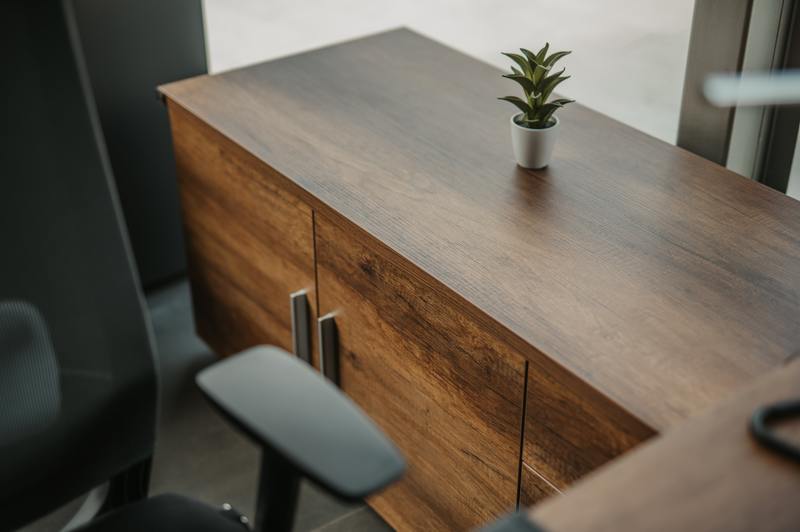To fix water-damaged veneer furniture, you’ll need to assess damage then make the repairs. Here’s a guide on how to repair water damaged veneer furniture. Don’t worry; it’s easier than you think!

How does wood veneer get damaged?
There’s a thin, glossy layer of wood on veneer furniture. This layer is called the wood veneer. It’s a popular choice for those who want a polished look.
However, wood veneer is not immune to water. When it comes into contact with water, stains and discoloration can happen.
Sometimes, the water penetrates the wood. The wood then swells, separating the veneer from the wood itself.
That’s why it’s essential to notice the signs of water damage early on. You can still fix the veneer furniture when the water damage is minor.
Repairing water-damaged veneer furniture is relatively simple, too. Read on to find out how.
How To Fix Water-Damaged Veneer Furniture
There are many approaches to fixing water damaged veneer furniture. You’ll need to figure out the type and severity of the damage first.
Step #1. Assess the damage
Take a good look at the veneer. Do you notice any spots, stains, or discoloration? That’s most likely water damage.
If your furniture has white spots, then that’s caused by splashed water. It can happen when you place a glass of water directly on the wood veneer. It can also occur if you accidentally spill some water on the surface.
Blushing happens over time. When your furniture is old, the veneer usually has a white, foggy look. It can also occur if the finish was applied, even if the wood wasn’t completely dry.
It’s a bad sign if your veneer furniture has black spots. The spots mean that the water has already seeped through the veneer and into the actual wood. When this happens, it’s time to call a professional.
Step #2. Fixing the veneer furniture
You can fix minor water damage on veneer furniture. However, you’ll need to put in a little effort. Buckle up; there’ll be a lot of rubbing and scrubbing involved!
2.1. White spots
To remove white spots on veneer furniture, you can choose from liquid furniture polish, denatured alcohol, or cigarette ashes with oil. All three methods are effective in removing those pesky stains.
Put a small amount of your chosen stain remover on a soft cloth. Afterward, gently rub the fabric on the area of the white spot.
Be careful, though. If you rub too harshly, you might strip some of the veneer’s finish off. When the white spots are gone, remove the stain remover with a clean cloth.
Don’t forget to put two layers of furniture wax on the surface. The wax will repolish the veneer and add a glossy shine.
2.2. Blushing
You’ll need more effort to remove blushing. Take coarse grit sandpaper and carefully sand over the affected areas. Follow the direction of the wood grain.
Once the wood’s color is back to normal, wipe off the dust with a clean rag. You can now apply two layers of furniture wax to repolish the veneer.
If that doesn’t work, there’s still another method. It is called re-amalgamation. You’ll need to use either denatured alcohol or lacquer thinner to dissolve the veneer finish.
Rub the blushed area until the blushing disappears. Blend the edges with careful brush strokes. You should leave it to dry before applying two layers of furniture wax.
2.3. Black spots
What should you do if your veneer furniture has black spots? Black spots usually indicate significant water damage. The best thing to do is call a professional.
If a sudden situation like a hurricane or a burst pipe causes water damage, you might be able to get homeowner’s insurance to pay for the repairs. Check your insurance coverage to see if it is possible.
You can’t fix black spots on veneer furniture on your own. There are other options, though. You should either call a professional or replace the veneer furniture entirely.
Can veneer furniture be refinished?
If you want to give your veneer furniture a lift, you can opt to refinish it. To refinish veneer furniture, you’ll need a chemical stripper to remove the existing finish.
The process is like the re-amalgamation method mentioned earlier. Remove the finish, sand the veneer down, apply sealant, then use varnish. The last step is to apply a few coats of polyurethane to the surface.
How do you protect wood veneer?
It’s always good to prevent water damage early on. If you wish to avoid water damage on wood veneer, here are a few things that you can do.
You can use coasters and desk pads to protect your wood veneer. Some people even opt to place a glass top on their furniture. Lastly, don’t forget to clean your furniture regularly.
Conclusion
Veneer furniture is a timeless choice. There are ways to repair and refinish veneer to keep it looking as good as new.
If it ever becomes water damaged, don’t fret! You now know how to repair water damaged furniture.
